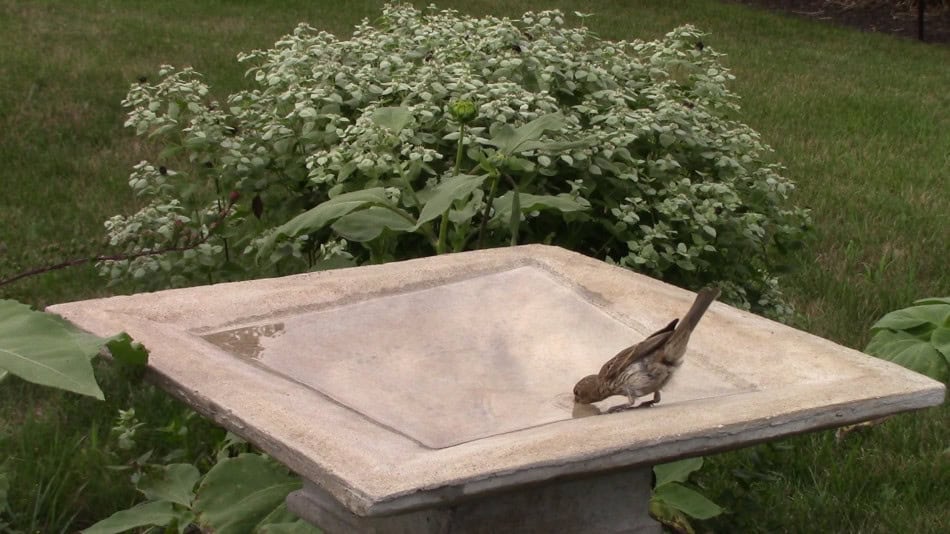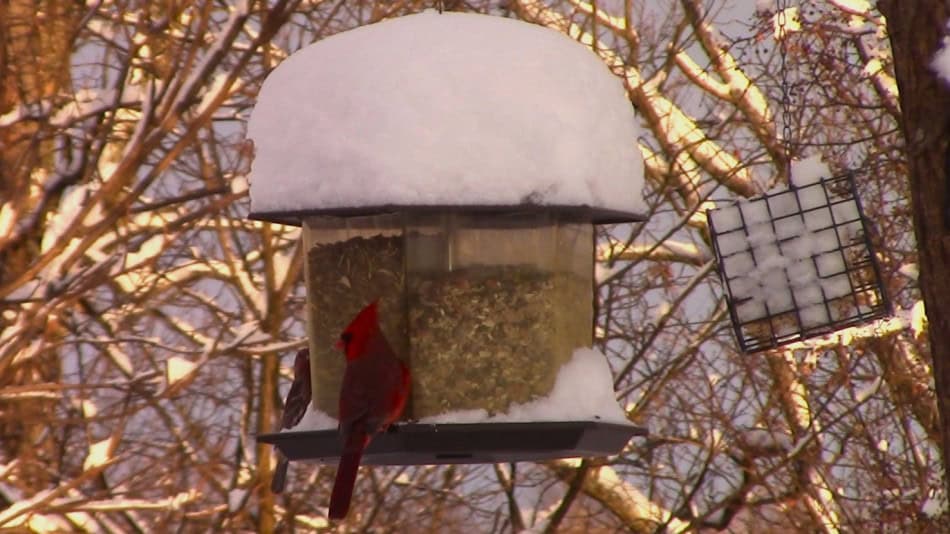When it comes to improving our backyards for wildlife, most of us (myself included) often focus on plants. Adding flowers for bees, trees and shrubs for hosting pollinators provide huge benefits for my local ecosystem, and yours too! But there are some other methods one can undertake to help wildlife in our own backyards, some which are obvious and others which maybe a little more subtle, but not less important! This can be of particular interest to those who rent, as even if your lease doesn’t allow you to change the landscaping, you may be able to do some of the other items on this list. So, read below to see ten ways you can improve your local backyard ecosystem that doesn’t involve plants!
1- Add a birdbath
This is one of the most common, and beneficial ways you can help out your local feathered friends. Birdbaths can keep a bird cool on hot days while allowing them to stay hydrated. There is a bit of an upfront cost, and you need to work to make sure they stay clean and filled with water, but the benefits to the birds make it worth it. And you can make it an attractive feature in a curated native plant garden or any formal flower bed!

2 – Create a pond
This one may be a bit more ambitious, but a pond can really improve your local ecosystem. How? Well, the pond will fulfill the function of a birdbath, but also can serve as frog habitat. Furthermore, it can help attract dragonflies, which prey on many of the backyard insects we don’t like such as mosquitos.
Unfortunately, ponds are not free! They generally cost a lot of money, but it can make for an excellent feature in a garden that reaps big benefits for your backyard wildlife.
3 – Hang birdfeeders
Simply put, hanging birdfeeders is an easy way to feed birds in winter, while also providing you some entertainment! You get to enjoy the flurry of activity every morning and throughout the day.

Now, birdfeeders and birdseed aren’t free, but I’ve found that as long as you keep the squirrels and deer away the cost isn’t much. Seriously, the only time feeding the birds gets expensive is when deer or squirrels help themselves! If you need some help in this department, click here to see how I’ve successfully defeated the deer and squirrels in the battle for my birdseed.
4 – Put up a nest box
So, Bluebirds used to be on the endangered species list, primarily from a lack of habitat. But, after many decades their numbers have been brought back by the use of bluebird nest boxes installed in public places like parks and wildlife refuges. Homeowners have also helped by installing nest boxes right in their own back yard – and you can do this too!
You may have different visitors than bluebirds though, in that many species will utilize nest boxes. Don’t think your yard is too small though, as I have a half-acre lot and I have three nest boxes installed. And believe it or not, all three are usually producing 1-2 broods per year!

I have two houses set up with a smaller hole (1-1/8″) which means only Chickadees and Wrens can enter, and my third house is the standard 1-1/2″ diameter for Bluebirds. This set-up has worked great, as the Chickadees are protected from larger birds pilfering their nests, and the Bluebirds reliably use the 3rd house every year.
But see here for an overview of different nest box styles, and here for my plans for a single-board cedar bluebird house (which is what you see in my pictures). Oh, and don’t forget the robins! They like to build nests on trees, platforms, and shelves. I have plans (with cutout template) for a robin nest shelf here.
5 – Put up a bee hotel / bee house
Bee hotels are a fun way to provide habitat for native bees that like to nest in holes or hollow stems. You can simply drill holes in a log to provide habitat, or you can make a dedicated home.

My old ‘stump on a stick’ bee hotel is still going strong. Next year I’m going to experiment by saving some hollow stems from the previous year so that clean out is a breeze.
6 – Install a bathouse
Alright, this one might take some careful spousal-persuasion, but bats are part of our ecosystem, and like the Field of Dreams movie says, “If you build it, they will come”.
Bat houses are simple structures that can be constructed from scrap lumber or inexpensive cedar pickets. It would make a nice afternoon winter project, and would provide nice habitat for our furry flying insect eaters!
7 – Leave a brush pile
This is one of those strange benefits that most people wouldn’t consider. But leaving a brush pile can be a huge benefit for backyard wildlife. It provides cover for birds, rodents, and other critters to keep them safe from hawks and the like. Think about it, nature makes brush piles all the time! So, whether you want to just leave your gardens standing all winter, or put all the pieces into a brush pile, the benefits to your backyard wildlife will be great.
8 – Don’t use pesticides on your lawn
This is one of those ‘via negativia‘ benefits…..where by not doing something bad, we will have good things happen. But, simply put, don’t put weed killer or insect killer on your lawn. By doing this, you will inevitably have ‘weeds’ pop up, but these weeds will help pollinators. You can’t poison a bee if you don’t use poison.

But you will also create some interest in your lawn in the form of flowers that will magically appear over time. These flowers feed pollinators and other insects, which gives direct benefits to your backyard wildlife. See here for a list natives that can grow in your lawn and survive being mowed.
9 – Keep cats indoors
This one is another example of via-negativia. Domestic house cats are not native to North America, and harm wildlife by killing birds – both adults and fledglings. But they will also kill other native rodents like field mice, shrews, and baby rabbits. Keep them indoors. These small native animals have a tough enough time surviving the hawks, fox, raccoons, skunks…etc.
10 – Put out fruit peelings for pollinators
This one may seem a bit strange, but rather than directly composting fruit peelings, why not consider putting them outside on a plate first? Even though you are done with the peelings, there is still sugar available that will happily be gobbled up by butterflies and bees. After a day, then just go dump them in your compost pile.
Conclusion
Overall there are many ways to support our local ecosystems, beyond plants! Incorporating some or all of these is a great way to improve your backyard wildlife situation. And it doesn’t need to stop with you – share what you do on social media or talking with friends, and show them the benefits you see. We all need to become more evangelical about natives and improving our environment. So installing an attractive birdbath, bragging about some baby bluebirds that were raised in one of the nest boxes, or even just commenting on the flurry of activity the bee hotel is can help!
Looking for more on your backyard wildlife? See here!
Recent Posts
Ok - so here is a little DIY Christmas gift for kids that is a lot of fun to make and shoot. A simple toy gun that shoots milk-jug caps...so that means ammo is free and you will never run...
Sweet Coneflower - A Complete Profile On Rudbeckia subtomentosa
Sweet Coneflower is a herbaceous perennial flower native to the Midwestern United States[1]. Scientifically known as Rudbeckia subtomentosa, it grows 3-5' tall in full sun and moist to medium-moist...
